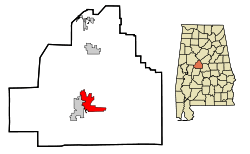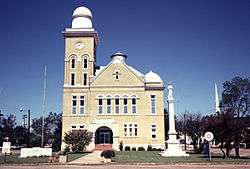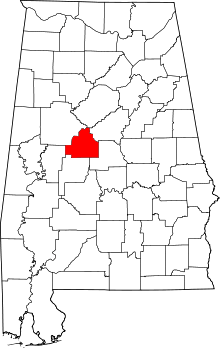Centreville, Alabama
| Centreville, Alabama | |
|---|---|
| City | |
|
Bibb County Courthouse in Centreville | |
 Location in Bibb County and the state of Alabama | |
| Coordinates: 32°57′0″N 87°8′4″W / 32.95000°N 87.13444°W | |
| Country | United States |
| State | Alabama |
| County | Bibb |
| Founded | 1823 |
| Incorporated | 1832 |
| Founded by | Sarah Willis Chotard |
| Area | |
| • Total | 9.6 sq mi (24.9 km2) |
| • Land | 9.5 sq mi (24.5 km2) |
| • Water | 0.2 sq mi (0.4 km2) |
| Elevation | 253 ft (77 m) |
| Population (2010) | |
| • Total | 2,778 |
| • Density | 294/sq mi (113.5/km2) |
| Time zone | Central (CST) (UTC-6) |
| • Summer (DST) | CDT (UTC-5) |
| ZIP code | 35042 |
| Area code(s) | 205 |
| FIPS code | 01-13672 |
| GNIS feature ID | 0159359 |
| Website |
centrevillealabama |
Centreville is a city in Bibb County, Alabama, United States. At the 2010 census the population was 2,778.[1] The city is the county seat of Bibb County.
Geography
According to the U.S. Census Bureau, Centreville has a total area of 9.6 square miles (24.9 km2), of which 9.5 square miles (24.5 km2) are land and 0.15 square miles (0.4 km2), or 1.52%, is water.[1]
Climate
The climate in this area is characterized by hot, humid summers and generally mild to cool winters. According to the Köppen Climate Classification system, Centreville has a humid subtropical climate, abbreviated "Cfa" on climate maps. [2]
Demographics
| Historical population | |||
|---|---|---|---|
| Census | Pop. | %± | |
| 1890 | 239 | — | |
| 1900 | 422 | 76.6% | |
| 1910 | 730 | 73.0% | |
| 1920 | 793 | 8.6% | |
| 1930 | 791 | −0.3% | |
| 1940 | 893 | 12.9% | |
| 1950 | 1,160 | 29.9% | |
| 1960 | 1,981 | 70.8% | |
| 1970 | 2,233 | 12.7% | |
| 1980 | 2,504 | 12.1% | |
| 1990 | 2,508 | 0.2% | |
| 2000 | 2,466 | −1.7% | |
| 2010 | 2,778 | 12.7% | |
| Est. 2015 | 2,704 | [3] | −2.7% |
| U.S. Decennial Census[4] 2013 Estimate[5] | |||
As of the census[6] of 2010, there were 2,778 people, 1,066 households, and 729 families residing in the city. The population density was 294 inhabitants per square mile (114/km2). There were 1,178 housing units at an average density of 122 per square mile (47/km2). The racial makeup of the city was 72.2% White, 23.7% Black or African American, 0.3% Native American, 0.4% Asian, 2.4% from other races, and 1.1% from two or more races. 3.0% of the population were Hispanic or Latino of any race.
There were 1,066 households, of which 29.7% had children under the age of 18 living with them, 47.2% were married couples living together, 15.9% had a female householder with no husband present, and 31.6% were non-families. 29.0% of all households were made up of individuals and 14.2% had someone living alone who was 65 years of age or older. The average household size was 2.50 and the average family size was 3.07
In the city the population was spread out with 23.8% under the age of 18, 9.0% from 18 to 24, 24.6% from 25 to 44, 24.6% from 45 to 64, and 18.1% who were 65 years of age or older. The median age was 39 years. For every 100 females there were 92.6 males. For every 100 females age 18 and over, there were 95.0 males.
The median income for a household in the city was $31,642, and the median income for a family was $58,000. Males had a median income of $37,614 versus $17,088 for females. The per capita income for the city was $18,172. About 13.5% of families and 15.9% of the population were below the poverty line, including 10.1% of those under age 18 and 1.1% of those age 65 or over.
History
The Cahaba River falls near Centreville, which made the town a strategic location for transportation through the region. The first post office in Bibb County was established in Centreville in 1821. Sarah Willis Chotard obtained a patent for land in this area in 1823 and began moving squatters off the land and laid out a plot for the new town of Centreville.[7]
In 1829, Centreville became the permanent seat for Bibb County after several years of debate and different locations of the county courthouse, and the town was incorporated in 1832.[7] Centreville's historic district is listed on the National Register of Historic Places.[8]
1910 lynching
In 1910, a white woman by the name of Mrs. Crow gave birth to a child of "doubtful color", who was thought by many to be the product of a relationship between Crow and an African American, and she was accused of having such a relationship. At first she vigorously denied it, but then – under intense peer pressure – she confessed to the baby's origin but claimed that she had been raped. When asked if she knew who raped her, Crow gave them the name of Grant Richardson, an African American who lived near the Braehead Slope Mine Camp, northeast of Centreville.
The miners and other local residents were so incensed at the affair that they decided to apply "summary vengeance" to Richardson as soon as they knew that the sheriff had apprehended him.
Deputy Sheriff Cam Riley apprehended Richardson on October 12, 1910, and was returning him to the jail at Centreville for processing and trial, but was waylaid by a lynch mob. The mob took Richardson from Riley and shot the suspect.
Chief Deputy Sheriff Charles Oakley investigated the scene as soon as word of the incident reached him, but other than the body, the shells, and the blood, there was little usable evidence to be found, much less witnesses. A coroner's inquest was held as soon as a special coroner was appointed, but there is no known result of that inquest. This was the first recorded lynching to take place in Bibb County.
It is unknown whether charges of either filing false charges resulting in a murder or miscegenation were filed against Crow, but it is known by those aware of Richardson that he had lived in the area for a number of years with a fair reputation prior to the incident.[9][10]
Education
Centreville is served by the Bibb County Public School District. Schools in Centreville include Bibb County High School (grades 9 through 12) and Centreville Middle School (grades 5 through 8).
Cahawba Christian Academy is a private school serving grades pre-K to 12.
Media
- WBIB 1110 AM (Southern Gospel)
- The Bibb Voice BibbVoice.com (Online News Publication)
- Centreville Press (Local News Paper)
Notable people
- Matt Downs, Major League Baseball infielder/outfielder
- Franklin Potts Glass, Sr., newspaper publisher and U.S. Senator-designate[11]
- Henry James, former NBA player[12]
- Ben Jones, offensive lineman for the Houston Texans
- Zac Stacy, former Vanderbilt University football player and current running back for the New York Jets
- Fresco Thompson, major league baseball player[13] and executive
References
- 1 2 "Geographic Identifiers: 2010 Demographic Profile Data (G001): Centreville city, Alabama". U.S. Census Bureau, American Factfinder. Retrieved September 16, 2013.
- ↑ Climate Summary for Centreville, Alabama
- ↑ "Annual Estimates of the Resident Population for Incorporated Places: April 1, 2010 to July 1, 2015". Retrieved July 2, 2016.
- ↑ "U.S. Decennial Census". Census.gov. Archived from the original on May 11, 2015. Retrieved June 6, 2013.
- ↑ "Annual Estimates of the Resident Population: April 1, 2010 to July 1, 2013". Retrieved June 3, 2014.
- ↑ "American FactFinder". United States Census Bureau. Archived from the original on September 11, 2013. Retrieved 2015-07-08.
- 1 2 Ellison, Rhonda C. (1999). Bibb County, Alabama: The First Hundred Years. University of Alabama Press. ISBN 0-8173-0987-X.
- ↑ National Park Service (2009-03-13). "National Register Information System". National Register of Historic Places. National Park Service.
- ↑ "Angry Miners Lynch Negro". Montgomery Advertiser. October 13, 1910. Retrieved July 23, 2011.
- ↑ "Lynch Negro for Assaulting Woman". The New York Times. October 13, 1910. Retrieved July 23, 2011.
- ↑ History of Alabama and Dictionary of Alabama Biographies, Thomas McAdry Owen and Maria Bankhead Owen, S.J. Clements Publishing Company: 1921, biographical sketch of Franklin Potts Glass, Sr., pg. 663
- ↑ http://www.basketballreference.com/players/playerpage.htm?ilkid=JAMESHE01
- ↑ Reichler, Joseph L., ed. (1979) [1969]. The Baseball Encyclopedia (4th ed.). New York: Macmillan Publishing. ISBN 0-02-578970-8.
Further reading
- Bibb County, Alabama: The First Hundred Years, by Rhoda C. Ellison
- "Bibb County", by Vicky Clemmons, David Daniel, Centreville Historic Preservation Commission
- Bloody Bibb, by Verrell Donald Elam. Elam Enterprises, 1985. 192 pages
External links
- City of Centreville official website
- Bibb County Public School District
- Bibb County High School
- Bibb County Chamber of Commerce
- Cahawba Christian Academy
- The Bibb Voice
- WBIB Radio
Coordinates: 32°57′00″N 87°08′05″W / 32.95°N 87.134708°W

